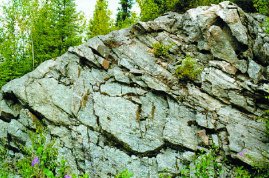Structure of the northeast portion of the Lac-Saint-Jean anorthositic series, Grenville Province; Chute-des-Passes area, Saguenay
Sophie Turcotte, Masters Thesis.
 Masters thesis under the supervision of Dr. Réal Daigneault.
Masters thesis under the supervision of Dr. Réal Daigneault.
Project description
The Lac-Saint-Jean anorthositic series (LSJAS) represents the most extensive Proterozoic anorthositic intrusion in the Grenville Province with an area of 20,000 km2. The study area is located in the northeast portion of the intrusion (Chute-des-Passes area) and overlaps the contact between the LSJAS and a gneissic complex made of varying composition. The anorthosite body includes dominant gabbroic to anorthositic phases. A coarse mauve-coloured apatite-rich phase forms a distinct mass of several tens of kilometres in size.
The first deformation event is recognised only in the gneissic complex and is represented by a gneissosity (S1) of varying strikes and dips due to folding and transposition by later deformations. The second deformational event produced a S2 fabric that is northeast-trending and moderate to shallow-dipping to the southeast. The LSJAS is characterised by bedding planes (S0) that are roughly parallel to the S2 fabric in most parts of LSJAS. A shallow-plunging, southeast-trending stretching lineation is also recognised and this signature is compatible with a transport direction toward the Northwest.
The southeast-trending contact zone between the anorthosite and the gneissic rocks corresponds to a km-size deformation zone (D3 event) where a subvertical S3 fabric is strongly developed in association with shallow plunging strike-slip stretching lineations. Shear-sense indicators infer dextral movement, in agreement with the LSJAS transport to the Northwest and the deformation zone acts as a décollement surface between two different deformation styles.
The last deformation event (D4) is characterized by northeast-trending deformation zones shallowly dipping to the east. Stretching lineations and shear-sense indicators suggest renewed thrusting with west to northwest transport directions. These zones could be interpreted as out-of -sequence thrusts. In a later phase (D5), these zones were the loci of dextral reactivation producing subhorizontal stretching lineations.
The thrusting signature is dominant in the LSJAS and is correlative with the Grenvillian Orogeny. A critical zone within the LSJAS displays decametric enclaves of the early anorthositic phase within the late, mauve, apatite-rich phase. The enclaves are strongly strained and demonstrate fabrics compatible with the thrusting signature associated with the D2 event whereas the mauve anorthosite contains fabrics produced only by the D3 event. This relationship and the overall structure of the anorthosite suggest an emplacement contemporaneous with thrusting.
Question or commentary contact me: sophie_turcotte@uqac.ca.
